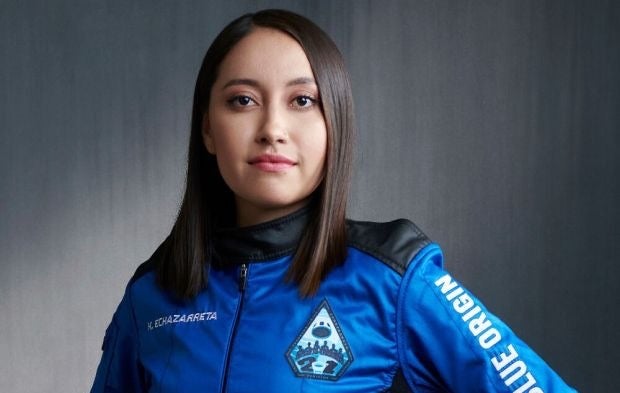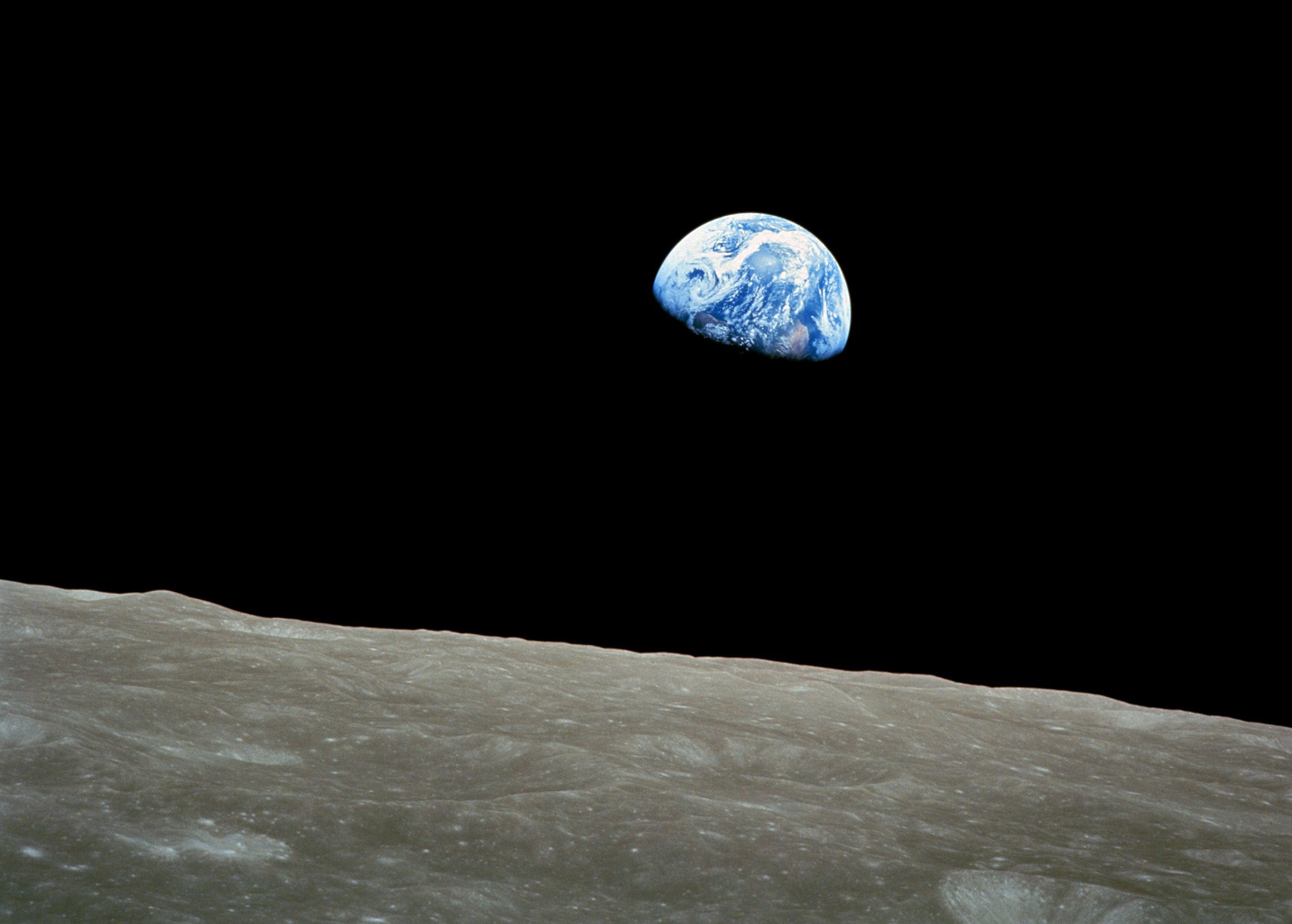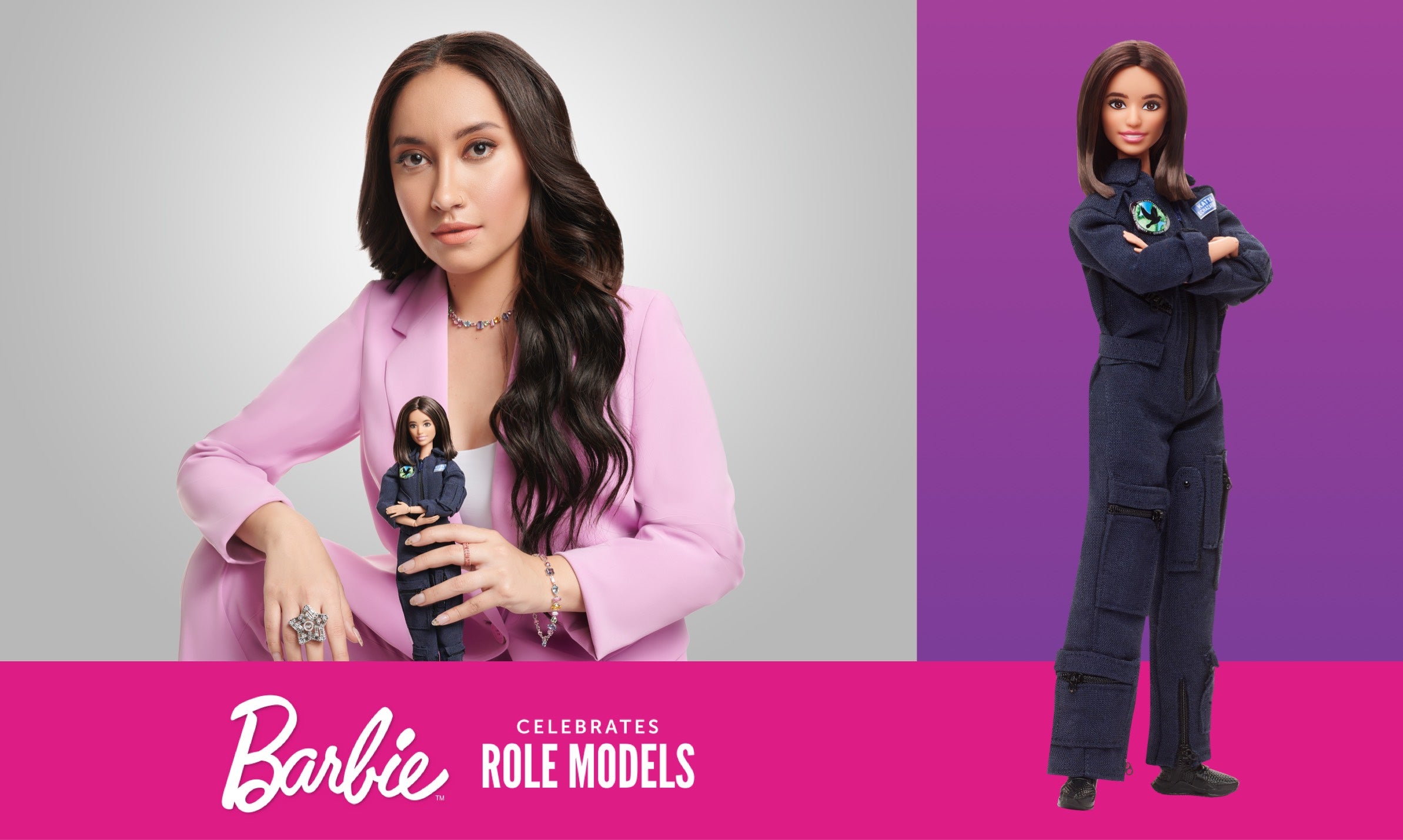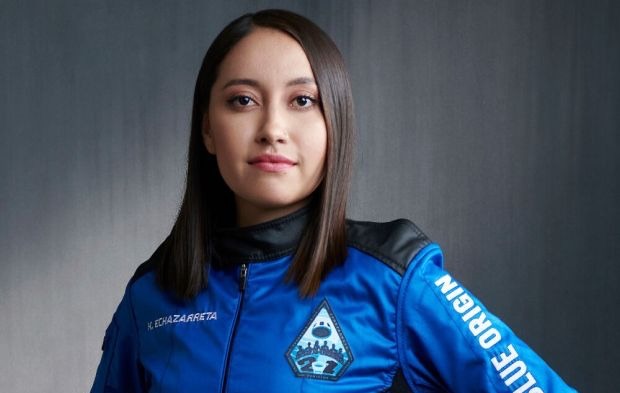
Katya Echazarreta.
Katya Echazarreta made history June 4, 2022, when she traveled to space aboard Blue Origin’s NS-21 flight as one of Space for Humanity’s citizen astronauts. Space for Humanity, an organization with a goal of making space accessible for all, has a Citizen Spaceflight Program that allows anyone to experience looking at Earth from above and experience the ‘Overview effect’. Echazarreta, was one of the first picked for this role.
Echazarreta, an electrical engineer, has worked on five NASA missions, including the Europa Clipper and the Mars 2020 Rover. More recently, she has focused on her foundation called Fundación Espacial Katya Echazarreta. An organization that makes space accessible to young kids, teens, women, and other scientists and engineers in Mexico. Fundación Espacial, although started in Mexico, is now expanding to accept applications from all over the world.
Astronomy interviewed Echazarreta via video about her current projects, hobbies, and journey to where she is now. The following interview has been edited for clarity.
Q. How did your interest in science start?
Echazarreta: I’ve always had this sort of innate passion and love for science or technology, particularly electricity and outer space. Those were kind of always my major loves growing up. I think initially, I didn’t really understand it as that to me. It was just something that I liked and gravitated towards. I would ask questions and look them up. It was very natural for me.
Q. You were part of five NASA Missions, one being the Europa Clipper. What was your experience being part of those missions?
Echazarreta: Yeah, so the Europa Clipper will launch at the end of this year, and I’m just so excited. It was one of the first missions I was assigned to at NASA in a flagship sense, meaning that most of my time would be dedicated to this mission. When you’re working on these missions, you might split your time between one, two, or even three [missions]. But for me, this mission was my main mission for quite a bit. I was essentially drafting up these simulations that will be used to test the flight computers.
These are the computers that are going to be part of the spacecraft. And to test them, we need to simulate their environment completely. We would create big systems that would simulate the entire spacecraft. And the computer itself would think, “Oh, I’m in the spacecraft, or I’m on my way to Europa right now.” We would test both functionality but also inject errors, which was fun. So you would inject things that were wrong to try to see how it’s going to react. Recently, I had the opportunity to visit JPL (Jet Propulsion Laboratory at NASA) and see Europa Clipper in the high bay before it gets shipped off to Florida.
Q. How was your first day as an intern at NASA?
Echazarreta: First, I was an intern, then I became a full-time engineer, but on my first day of work, my mentors gave me a tour around the lab. And essentially, we go up to this building, and they say to me, “open that door.” I opened the door, and they said go up those stairs and through that hallway. I’m confused looking back, like where are they going to take me, and I walk in not knowing what’s going to be there. It’s the viewing area with the Perseverance rover, which I already knew so much about. I grew up learning about these different Mars rovers, and Curiosity was such an important part of my decision, specifically, to become an electrical engineer working at JPL. So, to see that on your first day of work, and it’s the rover right there, and it’s massive, and there’s all these people dressed in white head to toe working on it, which was the most beautiful thing.
Q. Were you the first person in your family to pursue a STEM degree?
Echazarreta: So, I come from a family of engineers. But the difference here is that all of them have been men. So even though I come from a family of engineers, my dad’s an engineer, my grandpa was an engineer, my uncle’s an engineer, I am the first female engineer in my family. Initially, I think it would have been easier if no one in my family had been an engineer before versus what I had to deal with, which is essentially, my family and all of the men in my family thinking that my brother was the one that was meant for this career and not me.
But I’m grateful for [my brother] because if it weren’t for him being around, I wouldn’t have had access to opportunities like going to the different science museums and these different science kits that were given to him that he would essentially throw away. I would go and pick them up.
Q. How did you prepare to go to space? Was there any special training you had to undergo to prepare for Space for Humanity’s first space flight aboard Blue Origin’s NS-21?
Echazarreta: 2019 is the year that I applied for admission to space with Space for Humanity. And that was also the year that I started training on my own. There are a few different trainings that you can sign up for, especially as a student, to start gaining some of these different skills that you’ll need for a trip to space, particularly the launch and descent, which can be the heaviest portions. So, some of these trainings include microgravity training, which you can do in planes. It also includes high G force training; once again, you can do this in planes. You can also do that in different simulated environments. But I had this experience with an aerobatic aircraft, which is essentially the planes that do all the tricks at the air shows and can push you into those high G’s. I also got pressurized spacesuit training at Embry Riddle Aeronautical University. And I also had training with hypoxia. They start taking oxygen away from you so that you can start to sense what it will be like for you if you start feeling that loss of oxygen in your chamber. Everyone reacts differently. So, you need to understand what your symptoms are so you can recognize them. Contrary to popular belief, you’re still breathing normally when you start losing oxygen. So you don’t notice. It’s not like you’re choking because you still have air. It’s just the air lacks the oxygen necessary for your body. That’s when you start having these strange secondary effects. For me, I started getting tunnel vision, and I started losing vision in color. So, I slowly started to stop seeing color, which is outrageous. Passing out is the last thing you go through.
The application process took three years, so I had enough time to prepare and train. Something that’s always been very important for me is that I’m not going to wait until an opportunity is available to start practicing. If I know that that’s what I want, and I know what I need to get it, I will start preparing now. I’m going to start practicing now, and I’m going to start getting that education that I need now. Because if I wait until three years from now, then I’m going to be barely starting, versus if I start out, then I have three years under my belt.
Q. What has been your biggest struggle in your career so far? And how did you overcome it?
Echazarreta: I would say it would be just getting an education. When I was 17 years old, I had to go through these really difficult life and family matters where I didn’t have access to education anymore. I didn’t have the funds or the resources necessary to attend university. I had to work up to four jobs at a time to help my mom pay bills and, you know, all the general rent, electricity, etc. My siblings were younger. I have an older sister who has mental and physical disabilities. And so, I am 17 years old, and I’m stuck because I have to make sure my family is okay. But if I don’t go and try to pursue some education, which I desperately wanted, I know that our life is going to be pretty much like this for the rest of our lives.
We’re going to continue having to work those four or five jobs, and that’s never going to stop unless I find a way to do those jobs while also going to school. So, I ended up enrolling in community college. I don’t know how, but I maintained a perfect 4.0 GPA.
I was able to find out and discover [more opportunities] which is something you don’t understand or have access to, when you’re doing this on your own. But, I was able to figure out that if I were to do a summer research program, I can get paid just as much as I was getting paid before with all those multiple jobs or maybe even a little bit more because now the work that I’m doing is a little bit more specialized.
So, I started finding out and figuring out ways to use the education I’m slowly building to get better-paying jobs as I make myself or as I build myself up. That’s how I was able to make it through. I kind of just had to figure that out on my own. I also relied on support from various networks and mentors at the university level who essentially realized the potential I had even before I saw it in myself and decided to support me. I attended UCLA with two full rides, one from the university and another one from a national scholarship. And shortly after that, I was hired for my first job as a student at NASA. And it all kind of just grew from there, but getting past that mental barrier of knowing you need to work but also knowing that you need to get an education one way or another, I think, has been one of the most difficult things.
The origins of Fundación Espacial
Q. Are you still at NASA JPL?
Echazarreta: Not right now. No. So, right now, I have my own organization, Fundación Espacial. This organization aims to create and provide educational space training opportunities for people who currently live in a country that either doesn’t have a space agency, its space agency isn’t very strong, or doesn’t have access to a developed space industry within its nation.
Q. Is Fundación Espacial based in Mexico only, or has it been opened to anyone worldwide?
Echazarreta: It Initially started in Mexico. This year, we will be opening up our programs worldwide for the first time. So, we will launch our application for our main project, which is our air and space camps based in Mexico for the entire world. The whole world is going to have access to these programs. We’re hoping to launch the application for the students in the coming weeks. And essentially, it will be a program designated for or designed specifically for students ages 13 to 17. Along with the application, you are also applying for one of the 100 spots that we offer, and all of them come with full rides. This also really just stems from the experiences that I had growing up. I never want to put a price tag on an educational experience for a child.
Q. What was your experience like going to space?
Echazarreta: When you grow up and imagine that your entire life, you think you’ll have some sort of an idea. You think that, yes, it’s going to be thrilling and exciting and maybe a little bit scary but not entirely shocking. You have thought this through so many times, and you’ve seen so many films and documentaries, as well as just anything that a person can consume relating to this topic. But the reality of feeling those forces, the reality of feeling that microgravity, the reality of feeling the sun on your face with less protection from the atmosphere, and the way you start sweating immediately as soon as [the Sun] touches your skin in the way you turn around and turn away from it almost instinctively because of how strong those rays are, there’s just so much is happening at the same time you start to float, and you take off your seat belt. You turn around, and you know there’s the planet, and it’s the most beautiful and incredible thing you’ll see in your entire life. The colors, I mean, you think you understand colors, you think you understand their extent and range, but you don’t until you see how these colors look out in space. You realize that there are hues and shades that you have never been exposed to. Particularly that blue of the thin blue line, the famous thin blue line of our atmosphere. It’s the most beautiful color you’ll ever see.

Q. For your first space mission, you set out to study the overview effect. What was that like?
Echazarreta: The overview effect is a psychological shift in perspective that happens to people who can view the planet from the outside. It has been observed since the first few astronauts started going to space. As they started coming back, they kind of realized that they were different but different in a very positive way. As in, they wanted to help people. They wanted to create programs to help society. They would go into politics, and they would create their own organizations; they would become activist humanitarians. So, one by one, they started noticing this trend, and we wanted to analyze this psychologically, before, after, and then months after, which is what we’ve been able to do. And personally, I will say that it’s not exactly like the flip of a light switch, right? It’s not something that you see the planet flip, and now you’re different. You don’t feel it like that. It’s a lot more complicated. It’s a longer process than that. So, you start to realize when you come back, and you realize as the days go on, or as the months go on, and now I can say, you know, where almost two years post-flight, and I can say that there’s a very distinct difference between the person I was and the person I am today. I think it makes you bolder in your decisions. I think it makes you less afraid of trying to change something that might have seemed impossible before. I’m currently advocating for a constitutional reform in Mexico, but the goal here is to be able to take this to the rest of the nations that don’t have any legislation surrounding space activity. So, the goal is not one nation; the goal is all nations that might not have access to a legislative foundation for their own space activities. What we want to create with this legislation is to create the base of those laws necessary, so these different nations can start operating within this space of infrastructure and develop a space infrastructure. But if you had asked me before if I thought I would be working on changing a constitution and changing legislation and being involved in space law, my own projects, and my own fundraising for them, I mean, no, I don’t think that I would have before this shift in perspective would I have dared to do any of that, truly.
Q. Would you say the overview effect led you to create Fundación Espacial?
Echazarreta: Yes. The way that I envision the future for this organization and the projects that we have is as democratized as possible and as international as possible. I don’t want to reduce the space economy and the projects relating to space in the future down to one nation or one region because it’s going to take an international collaborative effort to be able to get these future technologies out into space and then also so that we can benefit from them and evolve as a species and as humanity. So it’s really important for me that everyone understands that the future of space exploration and the future of space development are together, and that’s why we’re seeing a lot of these different international treaties start to pop up. And that’s why we’re seeing a lot of these different collaborative efforts in the recent years and months of countries working together to get them together because as we go further and as we go longer [into space], we’re going to need to stick together.
Q. Who was your inspiration or someone that you looked up to?
Echazarreta: I’ve always really looked up to Ellen Ochoa, who became the first Hispanic woman in space. She has been a guiding light for me for so long because we come from a similar background. We both studied the same career. She’s also an electrical engineer. And she’s also from California. So, for me, that kind of always felt like a very special connection.
When I was in college, my husband, who was my boyfriend at the time, emailed her a picture of me studying in my studio, just mountains of books, and asked her to send me back a letter and an autographed photo, and she did. And so that is a photo and a letter that I keep around in my office. And I mean, I’m just a random college student to her at this point. You know, I haven’t gotten to NASA yet. I had not even applied or started training for space yet. I’m just a college student stressed out of my mind and did not know how I was going to make it through this when she sent that over to me. So, when I was able to get in touch with her again after my selection for space, she was one of the first people who congratulated me, and I was able to remind her of what she did for me back when I needed it most. So, you never know the kind of change or impact you’re creating when somebody reaches out to you, and that’s why it’s also so important for me to be present. During these programs [for Fundación Espacial] during last year’s camps, we had an entire month’s worth of them, and I was there every single day. I had a couple of business trips in between, but every single group of students that came in, all 100 of them, were able to meet me and ask me anything they wanted to.
Q. What was your favorite part about interacting with the students at Fundación Espacial?
Echazarreta: The students that we select for these projects are so incredibly intelligent. But beyond that, they’re so passionate, and they’re not afraid. I think that the coolest thing about working with kids is that they have the rest of their lives ahead. And we’ve selected to begin training with them at 13. So, we work with them from anywhere from 13 to 17 years old, but the earliest that we start working with them is 13 years old. And that age is very strategic for us because if you recall but also statistically, we’ve been able to analyze that, that middle school age is kind of when they start deciding on whether they’re going to allow peer pressure or external opinions to impact and affect the decisions that they make about themselves about their self-worth and their futures. That is why that age is so important: we want to be able to be there to counteract any of these negative things they might be experiencing in the real world. And just laser-focusing them on this path that we really believe can be a success for them based on the aptitude that they’re already displaying.
Q. What would you say to inspire a young woman who wants to go to space or be an engineer?
Echazarreta: A lot of us sometimes wait for an opportunity to arrive. We sometimes wait for the right moment for us to be ready for an application, a program, or a project, and if any of you are as big of a perfectionist as I am, that moment is never going to arrive. You’re never going to feel ready enough. You’re never going to feel educated enough or prepared enough because you’re not. There’s always more you can do, and that’s okay. But making that decision in this moment of, maybe I don’t know all of it, maybe I don’t have everything, but that doesn’t matter. I’m going to go for it anyway. And then I’ll figure it out as I go. That’s how you’re going to be able to make it out here and achieve all these massive goals.

Q. Can you tell us about your collaboration with Mattel in creating a Barbie doll in your likeness?
Echazarreta: I currently have two different Barbies. One of them has the flight suit that we used last year for our camps [at Fundación Espacial], and the reason for that is that I wanted our students to see themselves as an item, an object that they also have reflected and represented in this Barbie. The first one that we collaborated on with Mattel is wearing the flight suit that I used for my training. That also was a very strategic choice because I could have put on the final suit that I wore to space, but I think it was more important for her to wear the suit that I was wearing while I trained. The flight suit that I was wearing when these opportunities weren’t already here when I was putting myself in these situations to get out there. So that has been a very beautiful experience.
Q. You built an electronics lab in your home. What kind of projects do you work on there?
Echazarreta: So, this actually started during the pandemic. When I was working at NASA, and a lot of the testing and prototyping that I needed to do, I needed to go to the lab, but unfortunately, as we all know, during those times, everything kind of shut down. But it was still very iffy on how long they were going to be open. And when you’re dealing with something like what we were working on, which is the testing of these computers, I mean, that’s the brain of the mission. It’s very important to be able to get these computers ready to go, and for that, we need to get the prototypes ready to go. So I decided to create this lab, and I would bring some of the work home and I would do the testing at home and the prototyping at home.
I kind of just slowly started building up the equipment and would upgrade as I saw fit and necessary, but then that also opened up a whole other door because now I have access to this equipment at home. And I can teach people things. When I was a student, I really struggled with a lot of this equipment and one of my first few tasks at JPL. I remember I really struggled because, at my university, the equipment we had was old. And it did not look whatsoever like the equipment that we were using at work. So I didn’t know how to use it because it was too new and too advanced, and I didn’t have access to something like that to learn. That’s when I got the idea of starting to create some of these different educational videos for people who are just starting out. They may be first-generation, they don’t have anyone they can ask, or they’ve never really had an internship before. Or maybe they’re embarrassed at their internship, and they want to do the best job possible, which I totally can relate to. That’s really where that kind of transition, and right now, that’s what I mostly use it for to be able to teach others about this field that I love so much.
Q. Do you have any other hobbies that you enjoy?
Echazarreta: I love to read. This is something I don’t usually show because it’s kind of like behind-the-scenes. So if you’re looking at my workshop and my camera is facing this way, behind the camera on the other side is an entire wall just filled with books, and I’ve had to let go of a few every time I move and kind of do a cleanse, and I somehow end up with more than I had before just a few months later. So, I have my collection of books and I have an entire collection of a few different first editions as well. So, it’s a two-sided hobby. There’s the collection side of it and then also the actual reading and enjoying the content side of it.
Q. Do you have a favorite author?
Echazarreta: I love Carl Sagan. Carl Sagan has been a very inspirational and important part of my life, especially as I transition into the science communication side of things. For fiction, it’s funny, but I have an entire Stephen King collection.
Q. You have been on shows like ‘Mission Unstoppable’ on CBS and Netflix’s IRL (above). Do you see yourself hosting your own science show in the future?
Echazarreta: I think that’s something that I would love to get back to. And I mean, I’ve spoken to my team about what that might look like. But I think definitely. It’s always going to be something STEM-related. It’s always going to be something with a connection to space. And particularly the reason why it is so important is because we don’t have a lot of figures who are women and who are Latinos, particularly in these spaces. And the more that we’re able to show that Latinos do take up these spaces and that we don’t necessarily have to call out anything relating to those physical aspects or those different attributes, but rather I just happen to be the person teaching you and I just happen to be the person that is knowledgeable enough to share this information with you, and the other things just happened to be part of who I am. I think that’s going to be a large step that we can take as well in terms of the younger generations starting to see that, whether it be on television or the internet, and dispelling some of those ideas that they may have had about who can and who can participate in these fields.
Q. Do you see yourself going into space again?
Echazarreta: I do. I would love to. I always tell people I’ll go two more times. I want to go into space one more time in the near future, and then I would love to go to the Moon. So, the way that the industry has been evolving, in the way that also the different nations have been accepting and entering into this industry, I really foresee that access is going to become a lot more open and a lot more democratized in the new future.
Q. Do you see space exploration as a way to unify the entire planet?
Echazarreta: I do. Because I think that once we’re able to sort of leave the planet and get that perspective of looking back, which takes us back to the overview effect. It’s going to start allowing more people to truly understand that humanity aspect versus that divided aspect within the world.
Q. Where do you see yourself in 10 years?
Echazarreta: In 10 years, I think I see the organization that we’re creating in such a point that we’re able to offer a lot of these different educational opportunities to people all over the world but at the same time being able to have different departments and different training centers set up throughout the world. I would also love to invest in space technology within some of these countries, which are still up and coming within the space economy. And beyond that, I also see myself as participating in other future space missions.










